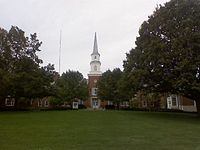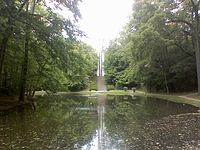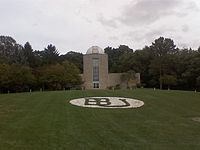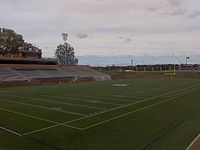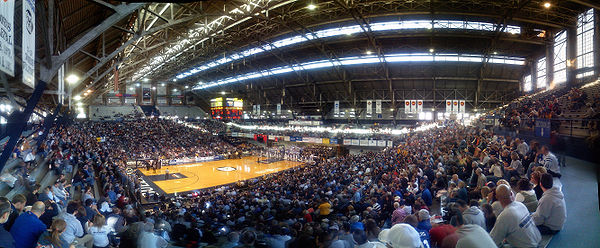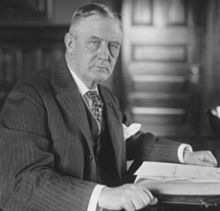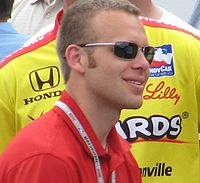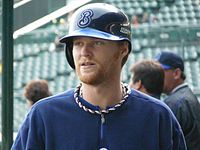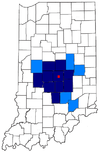- Butler University
-
Butler University 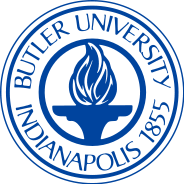
Motto Education, Research, Service Established 1855 Type Private Endowment $128 million[1] President James M. Danko Provost Jamie Comstock, PhD Admin. staff 328[2] Students 4,512 (Fall 2009)[2] Undergraduates 3,897 (Fall 2009)[2] Postgraduates 615 Location Indianapolis, Indiana, United States Campus Urban: 290 acres (120 ha)[2] Athletics 19 Division I NCAA teams[2] Colors Butler Blue and White[3]
Nickname Bulldogs Website www.butler.edu Butler University is a private university located in Indianapolis, Indiana. Founded in 1855 and named after founder Ovid Butler, the university offers 60 degree programs to 4,400 students through six colleges: business, communication, education, liberal Arts and sciences, pharmacy and health sciences, and fine arts. It comprises a 290-acre (1.2 km2) campus located seven miles (11 km) from downtown Indianapolis.
Butlers's athletic teams compete in Division I of the NCAA and are collectively known as the Butler Bulldogs. They are members of the FCS's Pioneer League for football but are members of the Horizon League for all other sports.
Contents
- 1 History
- 2 Campuses
- 3 Academics
- 4 Athletics
- 5 Student life
- 6 People
- 7 References
- 8 External links
History
On November 1, 1855, Butler University was opened as "North Western Christian University" at 13th street and College Avenue on Indianapolis' near north-side at the eastern edge of the present "Old Northside Historic District" on land provided by attorney and university founder Ovid Butler.[4][5]
In 1930, Butler merged with the Teacher's College of Indianapolis, founded by Eliza Blaker, creating the university's second college. The third college, the College of Business Administration, was established in 1937, and the College of Pharmacy and Health Sciences was established in 1945, following a merger that absorbed the Indianapolis College of Pharmacy. The Jordan College of Fine Arts, the university's fifth college, was established in 1951, following a merger with the Arthur Jordan Conservatory of Music. Butler's School of Religion, established in 1924, became independent in 1958 and is currently known as the Christian Theological Seminary.[6]
Butler University was founded by members of the Disciples of Christ church, though it was never controlled by the church.[6] The university charter called for "a non-sectarian institution free from the taint of slavery, offering instruction in every branch of liberal and professional education."[6] The university was the first in Indiana and the third in the U.S. to admit both men and women. Butler was also the first university in the United States to endow a chair designated specifically for a woman, the Demia Butler Chair (endowed in 1869). Catharine Merrill, the first person to hold the chair, became the second woman named to be a professor in an American university.[6] Further, the university established the first professorship in English literature and the first Department of English in the state of Indiana.[6]
Campuses
Irvington campus
The original location of the school was 13th Street and College Avenue on the near-northside of Indianapolis.[5] In 1875, the university, renamed for Ovid Butler "in recognition of Ovid Butler's inspirational vision, determined leadership, and financial support," moved to a 25-acre (10 ha) campus in Irvington, IN. The campus consisted of several buildings, including an observatory, most of which were demolished in 1939. The Bona Thompson Library at the intersection of Downey and University avenues, designed by architects Dupont and Johnson, is the only remaining building, although several buildings that housed faculty still remain, such as the Benton House.[4]
Fairview campus
Enrollment at Butler increased following the end of World War I, prompting the administration to examine the need for a larger campus. The new campus, designed in-part by noted architect George Sheridan, was formed on the site of Fairview Park, a former amusement park on the city's northwest side.[4] Classes began on the 290 acres (120 ha) campus in 1928.[2]
Buildings
The first building on the Fairview campus was Arthur Jordan Memorial Hall, designed by Robert Frost Daggett and Thomas Hibben. The structure's Collegiate Gothic style of architecture, created by architect William Tinsley and used on the previous Irvington campus, set the tone for subsequent buildings erected on the campus over the next three decades.[4][6] Also in 1928, the Butler Fieldhouse (later renamed Hinkle Fieldhouse) was completed after being designed by architect Fermor Spencer Cannon. The building remained the largest indoor sports facility until the mid-1960s.[4] The Religion Building and Sweeney Chapel were completed in 1942. These structures, designed by Burns and James, were remodeled into Robertson Hall in 1966.[4] The building now serves as the university's alumni and admissions offices.
Following World War II, construction began on the student center, Atherton Union (designed by McGuire and Shook). This building was remodeled in 1993 and includes an on-campus Starbucks.[4] McGuire and Shook also designed Ross Hall, a dormitory originally designed for men but is now coed, and Schwitzer Hall, a women's dormitory.[4] Art Lindbergh, with help from Daggett, designed the Holcomb Observatory and Planetarium, which was dedicated in 1955. This building houses Indiana's largest telescope.[4]
Acclaimed architect Minoru Yamasaki, who designed the World Trade Center, designed Irwin Library which opened in 1963 and serves as the university's main library.[4] Also in the early 1960s, Lilly Hall and Clowes Memorial Hall were constructed following the move of the Arthur Jordan Conservatory of Music to the campus. Clowes was designed by architect Evans Woollen III (Woollen, Molzan and Partners) and John Johansen. Ten years following the construction of Clowes and Irwin, the science complex of Gallahue Hall and the Holcomb Research Institute (now known as Holcomb Building) were built, completing the "U" shape of academic buildings.[4] The Holcomb Building now houses the College of Business, Ruth Lilly Science Library and Information Technology.
The Residential College ("ResCo"), designed by James and Associates, was the university's last major construction project of the twentieth century. Completed in 1990 the building serves as a cafeteria and a dormitory.[4] In 2001, the Fairbanks Center for Communication and Technology was opened to house all of the school's media arts programs. The Fairbanks Center houses two multi-purpose studios for video, television and music production, as well as three professional music and audio recording studios. Early 2004 saw the addition of the Eidson-Duckwall Recital Hall onto Robertson Hall. The 140-seat concert venue, serves as a showplace for student, faculty, and guest recitals.[7]
Butler built the 85,000-square-foot (7,900 m2) Health and Recreation Complex (HRC) in 2005. The HRC offers a jogging track around a two-court gymnasium, an aquatic complex, free-weight room, cardio and selectorized weight machine area, fitness assessment & massage therapy room, a sauna, two multipurpose rooms, and locker rooms. Outside of the fitness dedicated space, the building houses a conference room, juice bar, and student lounge.
On May 8, 2008, Butler broke ground on a 40,000-square-foot (3,700 m2), four story addition to Pharmacy Building. This building, designed by Browning Day Mullins Dierdorf, is home to faculty offices, classrooms, and laboratories to support Butler's Pharmacy and Physician Assistant (PA) programs.[8]
Other important sites on campus include Holcomb Gardens, 20-acre (81,000 m2) gardens containing a statue of Persephone, a pond, and a local canal; Clowes Memorial Hall; Hinkle Fieldhouse; Irwin Library, designed by Minoru Yamasaki; and Holcomb Observatory and Planetarium, home to the largest telescope in Indiana.
Expansion
The Campus Master Plan Draft calls for additions and upgrades to buildings on campus as part of the university's ongoing effort to provide state-of-the-art facilities for its students. The projects are separated into three categories: near-term, mid-term, and long-term.
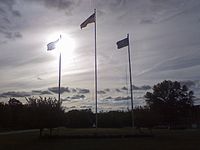 The flagpoles at Butler (Left to Right: Butler University Flag, Flag of the United States, Flag of Indiana)
The flagpoles at Butler (Left to Right: Butler University Flag, Flag of the United States, Flag of Indiana)
For the Arts & Sciences, near-term projects include an addition to the Holcomb Building to meet the space needs for science, math, and computer science. Also near-term are complete renovations to the floor-plan of Gallahue Hall and the renovation of Holcomb Observatory to upgrade the planetarium and observatory. Mid-term projects include renovations to Jordan Hall to upgrade finishes and increase "community" space. Following the science library's move to Irwin Hall, the space it currently occupies will also be renovated to community and study space.[9]
Student Housing projects call for the near-term building of a new 3-story, 150-bed residence hall behind Schwitzer Hall. Mid-term projects include renovations and infrastructure upgrades to convert Ross and Schwitzer Halls to contemporary standards, renovation of ResCo to upgrade finishes and convert selected areas back into community/gathering spaces, and the construction of remote parking across the canal to expand parking options on the core campus. Long-term projects include the construction of a new 3-story, 150-bed residence hall West of Ross Hall, and a parking structure between Schwitzer Hall and Phi Kappa Psi to expand parking options in the residential zone of the core campus.[9]
Near-term athletics projects include improvements to the Butler Bowl, which are currently under construction, including additional seating, a press box, concessions, restrooms, and lighting. Also in the near-term, Hinkle Fieldhouse renovations include infrastructural and interior upgrades, including the old pool area. Mid-term projects include the addition of a "Bulldog Plaza" on the south end of the Butler Bowl, improvements to the track, and adding lighting, parking, irrigation improvements and a press box to the Canal Field.[9]
Near-term projects for the Jordan College of Fine Arts include construction of a new 450-seat performance hall and sustainable "green" parking improvements tied to the Performance Hall project. In the mid-term, Lilly Hall will be renovated. Long-term plans call for structured parking to the east of Clowes Memorial Hall.[9]
In the mid-term, the top floor of Holcomb Building will be renovated for use by the College of Business Administration, creating directly adjacent space to the College's recently renovated space on the floors below. In the long-term, the College will be relocated to a new building to the north of Irwin Library, placing the College in a highly visible location with parking in close proximity. Further, the Garden House in Holcomb Gardens will be redeveloped into an Executive Education and Conference Center.[9]
Other near-term projects include a relocation of the Information Technology Department to the lower level of the Holcomb Building addition, the relocation of the College of Education to renovated space in what is currently the International School. Mid-term projects include an addition and renovation to Atherton Union and an addition to the south side of Irwin Library and renovating and upgrading finishes within the building. The plan also calls for renovating the space in Jordan Hall vacated by the College of Education. In the long term, the plan calls for the development of a new student union at the south end of the mall.[9]
Academics
University rankings (overall) National Forbes[10] 332 Regional U.S. News & World Report[11] 2 Over 55 undergraduate, one first professional and 17 master's degrees are offered in six academic colleges: Business, Communication, Education, Liberal Arts and Sciences, Pharmacy and Health Sciences, and Fine Arts. Butler ranks 2nd in the U.S. News & World Report's America's Best Colleges 2010 for Top Midwestern Master's Universities.[12] The university emphasizes practicality of knowledge and offers individual attention to its students with its small class size and no teaching assistants. Butler University increased its focus on faculty and student research with the Butler Institute for Research and Scholarship (BIRS), bolstered by a million dollar grant from the Lilly Endowment.[13] The University also provides student research opportunities, such as the Butler Summer Institute, a 10-week program where Butler students are granted funding to perform independent research with a faculty member.[14]
College of Business Administration
Butler's College of Business Administration is accredited by the AACSB International and The Association to Advance Collegiate Schools of Business.[15] The current Dean of the College is Prof. Chuck Williams. Butler's four year undergraduate business program began in 1937 and offers B.S. degrees in accounting, economics, finance, international management, management information systems, and marketing.[16] The school boasts 650 undergraduates, as well as 300 MBA students.[15] With 35 full-time faculty, 30 adjunct faculty, and 16 Executives-In-Residence,[15] the average class size is 25 students, and no class has more than 50 students.[16]
Butler University College of Business (COB) placed 58th in the Bloomberg BusinessWeek ranking of the best U.S. undergraduate business programs for 2011. The only Indianapolis business school in the ranking, Butler CBA received an “A” grade for teaching quality and tied for 13th in Academic Quality ranking, beating out all other Indiana-ranked schools.[17]
Butler Business Accelerator
A unique program in the College–the Butler Business Accelerator–allows students to serve as consultants for central Indiana businesses.[18] Developed through a grant from the Lilly Endowment, the Accelerator provides students with opportunities to experience business first-hand. Operationally, the Accelerator is a consulting business designed to serve middle market companies in Indiana. Teams led by professional consultants supported by faculty and students work directly with these companies providing a laboratory in which undergraduate and MBA students learn and experience real business problems and situations.[19]
College of Communication
The College of Communication (CCOM) is Butler's newest college.[20] CCOM includes programs run by the Department of Media Arts, the Department of Communication Studies and the Eugene S. Pulliam School of Journalism.[21] The mission of the college is to "prepare students for success in our digital and global society. Students will develop the ability to critically analyze and synthesize human and mediated communication, and learn to speak, write and create responsible messages across dynamic communication contexts and media platforms.”[20] The current Dean is Dr. William Neher. Program areas include Communication Sciences and Disorders, Critical Cultural Studies, Eugene S. Pulliam School of Journalism, Organizational Communication and Leadership, Strategic Communication (Including Public Relations and Advertising), and Media Production & Recording Industry Studies.[20]
Radio and broadcast television
From 1950 until 1994 Butler University owned and operated, what was at one point, the most powerful student-run radio station in the United States, WAJC, with an effective radiated power of 48,212 watts and circularly polarized transmitting antennas at 500 feet (150 m). In 1993 Butler sold the station and used part of the profit to upgrade the telecommunications (now "media arts") major and improve a donated building to support the program.
The school started WTBU, a PBS member station, on channel 69 in 1988. After competing for years with WFYI for PBS audiences, in 1999 then president Geoffrey Bannister signed an agreement to operate under a joint operating agreement. WFYI later absorbed control of the station, leaving Butler to run the academics. WTBU was eventually sold to the religious Daystar Television Network in 2005 and now is WDTI.
College of Education
Butler assimilated the Teachers College of Indianapolis to form a College of Education in 1930.[22] For the past seven years, the College has experienced a 99 percent (or above) placement rate for its students.[18] The current Dean is Prof. Ena Shelley. Undergraduate majors offered through the College are elementary education, middle childhood, middle/secondary education, health & physical education and exercise science, and music education.[23] The College also offers graduate degrees for those who complete the Experiential Program for Preparing School Principals (EPPSP), the master's program in school counseling, or the master's program for effective teaching and leadership.[23]
College of Liberal Arts & Sciences
The College of Liberal Arts and Sciences (LAS) stresses the importance and centrality of the liberal arts. The current dean is Dr. Jay Howard. Undergraduate programs include African Studies, Actuarial Science, Anthropology, Astronomy, Biology, Chemistry, Chinese, Classical Studies, Computer Science, Criminology, Economics, English, Environmental Studies, French, French & Business, Gender Studies, Geography, German, German & Business, History, International Studies, Italian, Mathematics, Peace Studies, Philosophy & Religion, Physics, Political Science, Psychology, Religion, Sociology, Software Engineering, Spanish, Spanish & Business, Urban Affairs, Individualized Major, and Exploratory: Liberal Arts & Sciences. Graduate programs include English Literature, Creative Writing, and History.[24]
Washington Learning Program
Butler University offers students a semester-long academic and internship program in Washington, DC. Because of the wide variety of corporations, government offices, and cultural institutions located in the U.S. Capital, Butler students from any academic major in any college are afforded the opportunity to participate in this program.[25] The program coordinator, Ivo Spalatin, is a veteran of international and political affairs with over 20 years of experience as a senior policymaker in Congress and the State Department. Mr. Spalatin works with students and faculty to individualize each student's experience in D.C. and monitors each student's internship and academic experiences throughout the semester.[26]
College of Pharmacy & Health Sciences
The College of Pharmacy and Health Sciences offers the doctor of pharmacy (Pharm.D.) degree that provides eligibility for licensure as a pharmacist. The College also offers a doctor of pharmacy with research emphasis, a graduate program leading to a master of science in pharmaceutical sciences degree, and a doctor of pharmacy/master of business administration program that awards both the Pharm.D. and M.B.A. degrees upon simultaneous completion of the respective degree requirements. The College of Pharmacy and Health Sciences also offers a master of physician assistant studies (M.P.A.S.). The current Dean of the College is Dr. Mary Andritz.[27]
The College of Pharmacy at Butler University originated in 1904 with the founding of the Winona Technical Institute. The institute was insolvent by 1910 and the Indianapolis Public Schools incorporated the pharmacy department for a time. In December 1914, the pharmacy department separated to become the Indianapolis College of Pharmacy (ICP). In 1930 the ICP became one of the first pharmacy colleges to create a four-year baccalaureate curriculum. In 1945 Butler and the Indianapolis College of Pharmacy merged, and erected a new building on Butler's campus in 1950. The building, with its fully mediated classrooms and state-of-the-art research and teaching laboratories, was completely renovated in 2008-2009. The name of the college was changed to College of Pharmacy and Health Sciences when the Physician Assistant program was developed in 1995.[28]
The Butler University College of Pharmacy and Health Sciences is a member of the American Association of Colleges of Pharmacy. The pharmacy program is accredited by the Accreditation Council for Pharmacy Education. By completion of the doctor of pharmacy curriculum, its graduates fulfill the educational requirements for examination and licensure as pharmacists in every state in the nation.[29] The 2010 edition of U.S. News & World Report's annual educational rankings listed the Butler College of Pharmacy and Health Sciences 56th in the country in a listing of the top pharmacy colleges.[30]
Upon completion of the pharmacy program, students are eligible to take the North American Pharmacy Licensing Exam ( NAPLEX), the national examination which leads to the licensure as a pharmacist. The passing rate for Butler pharmacy students on the NAPLEX is consistently above the national average, and in 2001, 2002, 2003, and 2004 and 2008 it was 100%. The college has the 7th highest board pass rates in the country, and is the #1 private institution with a 99.26% passing rate.[31]
Butler's Physician Assistant Program is a member of the Physician Assistant Education Association and is accredited by the Accreditation Review Commission on Education for the Physician Assistant. Graduates of the Physician Assistant Program must sit for the Physician Assistant National Certifying Exam (PANCE), the successful completion of which provides one the criteria for licensure or regulation.[29]
Jordan College of Fine Arts
The history of the Jordan College of Fine Arts (JCFA) extends from the year 1895, when the Metropolitan School of Music was founded. That school merged in 1928 with the Indiana College of Music and Fine Arts to become the Arthur Jordan Conservatory of Music, which was located at 3419 North Pennsylvania Street, currently a condo complex called "Charmwood". Classes were held in the mansion, and the surrounding auxiliary building, which was built in 1925 to match the mansion, held the dormitories.
In 1951, after 23 years of close affiliation, the conservatory became a part of Butler University as Jordan College of Music. The name was changed to the Jordan College of Fine Arts in 1978.[32]
JCFA's stated mission is to educate students in the arts as professions by means of its undergraduate and graduate programs.[33] The Jordan College of Fine Arts offers both graduate and undergraduate programs, including degrees in Arts Administration, Dance, Dance-Performance, Dance-Pedagogy, Theatre, Recording Industry Studies, Multimedia, Electronic Media, Music Education, Music Composition, Instrumental Performance, Jazz Studies, Lyric Theatre, Music Performance, and Voice Performance.[23] The Department of Dance is an accredited institutional member of the National Association of Schools of Dance (NASD), the Department of Music is an accredited institutional member of the National Association of Schools of Music (NASM), and the Department of Theatre is an accredited institutional member of the National Association of Schools of Theatre (NAST).[34] The current Dean of the College is Prof. Ronald Caltabiano.[35]
Theatre program
Butler's Department of Theatre is known for producing works not commonly seen elsewhere. Focusing on physical and international theatre, Butler has staged experimental interpretations of Samuel Beckett, a complete season of Caryl Churchill Each summer a professional artist is invited to present a two-week intensive course on a topic not covered in the usual academic text. This has included work with Italian and Russian directors, an Indian classical dancer, Australian installation artists and a multi-national montage performance group.
Institute for Study Abroad
The Institute for Study Abroad, Butler University (IFSA-Butler) is a nonprofit organization founded in 1988 at Butler University. Its stated primary goal is "to provide quality study abroad opportunities, plus academic and personal support services, for qualified North American undergraduates seeking to earn academic credit through study abroad."[36] While the Institute for Study Abroad is affiliated with Butler University, it is not a department of the university. IFSA-Butler currently operates programs in Argentina, Australia, Chile, China, Costa Rica, Egypt, England, India, Mexico, New Zealand, Northern Ireland, Peru, the Republic of Ireland, Scotland and Wales. IFSA-Butler has awarded millions of dollars in merit-based and need-based scholarships over the past five years.[when?] Awards range from $500 to $5,000. Once a student finishes his or her study abroad program, Butler University processes the student's official transcript, with grade and credit translations, at no additional cost. Most colleges and universities in the U.S. treat the Butler University transcript as transfer credit.
Athletics
Butler University's athletic teams, known as the Bulldogs, compete in the NCAA Division I Horizon League and compete at the Football Championship Series level in the Pioneer Football League. In the past decade, Butler teams have captured 26 conference championships (in four different leagues). The Bulldogs have made appearances in NCAA National Championship Tournaments in men's and women's basketball, men's soccer, volleyball, men's cross country, lacrosse, and baseball. Butler won the James J. McCafferty trophy, awarded annually by the conference for all-sports excellence based on conference championship points, seven times, including three-straight from 1996-97 to 1998-99 and back-to-back years in 2001-02 and 2002–03, 2006–07, and 2009-10.[37]
Men's basketball
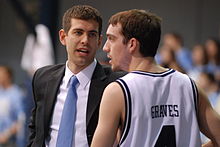 Butler head coach Brad Stevens, seen here speaking with A.J. Graves, has led his team to two NCAA Men's Division I Basketball Championship games since assuming the top position in 2007.
Butler head coach Brad Stevens, seen here speaking with A.J. Graves, has led his team to two NCAA Men's Division I Basketball Championship games since assuming the top position in 2007.
The Butler program has been one of the most successful "mid-major" basketball programs over the last decade, having won at least 20 games and reached postseason play eight of the last ten seasons, including six NCAA Tournament appearances.[38] Butler also holds two national championships in men's basketball from the pre-tournament era; one from 1924 (earned via the AAU national tournament), and one from 1929 (selected by the Veteran Athletes of Philadelphia).[39]
In 2010, Butler was runner-up to Duke, after advancing all the way to the National Championship after defeating Michigan State in the Final Four. With a total enrollment of only 4,500 students, Butler is the smallest school to play for a national championship since the tournament expanded to 64 teams in 1985. In 2011, the Bulldogs advanced to a second consecutive Championship appearance after defeating Virginia Commonwealth University in the Final Four. In the 2011 title game, Butler lost to the University of Connecticut.
Butler has the best winning percentage and most wins of all D-I men's basketball programs in the state of Indiana over the last decade (21.6 wins per year through 2006), while having won the last six meetings with in-state rival Notre Dame and two of the last four against Indiana.[40][41] Butler defeated both Notre Dame and Indiana during the 2006-07 regular season, while also defeating in-state rival Purdue to move to 2-0 against the Boilermakers this decade. Butler has also been the defending champion of the Hoosier Classic men's basketball tournament since the 2001-02 season,[42][43] and has advanced to postseason play nine of the last eleven years (7 NCAAs, 2 NITs). Butler has been to nine NCAA Tournaments and three NIT's since 1997.
Football
Over the course of 60 seasons from 1934 to 1994, Bulldog football teams have won 31 conference championships. This includes seven straight Indiana Collegiate Conference titles from 1934 to 1940, league titles in 1946, 1947, 1952, and 1953, and seven straight from 1958 to 1964, all under the late great Tony Hinkle. Following the move from the College Division to NCAA Division II, Butler won 4 straight conference championships from 1972 to 1975, and in 1977, all under the guidance of Bill Sylvester, Sr. Butler went on to win league titles in 1983, 1985, and three straight from 1987 to 1989, under coach Bill Lynch. The Bulldogs also went to the NCAA Division II playoffs in 1983 and 1988. Butler and fellow HCC member schools joined with the Great Lakes Valley Conference to form the Midwest Intercollegiate Football Conference (now the Great Lakes Intercollegiate Athletic Conference). Butler football dominance continued in this new conference with MIFC Conference Championships in both 1991 and 1992. These championships included a trip to the NCAA Division II playoffs in 1991 pairing Butler against eventual Division II champion Pittsburgh State.
Following the 1992 season, Butler and member school Valparaiso moved up to NCAA Division I-AA (now Division I FCS) to join with Dayton, Drake, Evansville, and San Diego to form the Pioneer Football League. Butler won another conference championship in 1994. In this era, "the Dawgs" were led by the great Arnold Mickens who broke numerous NCAA Division I rushing records, including eight straight 200 yard performances during the campaign. In 2009, Butler won its 32nd league title by winning the Pioneer Football League championship under coach Jeff Voris. The Bulldogs set a school record with 11 wins and went to the Gridiron Classic winning over Central Connecticut State 28-23.
Hoosier Helmet Trophy
The Hoosier Helmet was established as the trophy helmet for the rivalry football game played between Butler and Valparaiso University. The Hoosier Helmet was created prior to the 2006 season to commemorate the football rivalry that has existed since 1921. The helmet trophy was created to further intensify the rivalry between these two teams. A group of Butler players, along with their head coach, Jeff Voris, came up with the idea for the helmet. After Valparaiso head coach Stacey Adams agreed to play for the helmet, Butler equipment manager John Harding put the helmet together.
The white helmet is mounted on a hardwood plaque and features each team's logo on respective sides of the helmet. A gold plate is added each year to commemorate the winner and score of the contest. Currently, Butler holds a 4-1 series lead when playing for the Hoosier Helmet. Both Butler and Valparaiso compete in the NCAA FCS (formerly division 1-AA), non-scholarship Pioneer Football League.
Men's soccer
Butler's men's soccer qualified for the NCAA Tournament in 1995, 1997, 1998, 2001, 2009, and 2010, reaching the round of 16 in 1995 and 1998. Butler won the Horizon League (formerly the MCC) tournament title in 1995, 1997, 1998, 2001, and 2010. They also won or shared the regular season title seven times, including 1994, 1996, 1998, 2004, 2008, 2009 and 2010. The 1998 squad enjoyed national rankings as high as No. 8 in the country, and the 2010 squad finished the regular season as the only undefeated team nationally and were ranked as high as No. 6 in the country.
Men's ice hockey
In 2000, the Butler University Club Hockey Team won the American Collegiate Hockey Association's Division III National Championship, beating national runner-up Georgia Tech. The tournament was hosted by the U.S. Naval Academy. Butler currently competes in the Midwestern Collegiate Hockey Conference.
Cross country
Some of Butler's most notable athletic accomplishments have come in Cross Country. Butler has won 13 straight Horizon League Championships in Men's Cross Country and 8 of the last 9 Women's Championships. The Men's team has placed as high as 4th in the nation in recent years, earning a team trophy at the NCAA Division I championships in 2004. Both teams have frequently qualified for nationals in recent years, placing individuals as high as 3rd (Mark Tucker, 2003). All-Americans from the Butler Cross Country Team include Julius Mwangi, Justin Young, Fraser Thompson (A Rhodes Scholar), Mark Tucker, Olly Laws, and Andrew Baker. Former coach, Joe Franklin, was named NCAA Division I Coach of the Year for leading the Bulldogs to their 2004 4th place finish.
The Butler Bowl and Hinkle Fieldhouse
An interior panorama of Butler University's Hinkle Fieldhouse, constructed in 1928, during a game between the Bulldogs and the University of Wisconsin Green Bay.
From Butler's earliest days, athletics played a major role in shaping Butler University. When the school moved to its current Fairview campus location, two of the first structures completed were a 15,000-seat fieldhouse and a 36,000-seat football stadium. The football stadium, which came to be known as the Butler Bowl, is home to Butler's football and men's and women's soccer teams. The stadium was downsized to a 20,000-seat stadium in the mid-1950s, and later seating dropped to below 6,000. Recent changes to the Butler Bowl and its landscape have included removal of the Hilton U. Brown Theatre in 2004, installation of a synthetic turf playing surface in fall 2005 and the addition of the Apartment Village on the east side of the complex in 2006. Construction has begun on a major renovation at the Butler Bowl that will include building a brick press box with multi-use booths and new seating on the west and east sides of the playing surface. The renovation of the facility will increase the seating capacity to 5,647 with the addition of new bleacher seats along the west side of the field and a section of seating for visiting fans on the east side. The brick press box will be approximately 40 yards long, reaching between the field’s two 30-yard lines. The main level will have home and visitor radio booths along with private booths for home and visiting coaches. Also, there will be an expanded area for game operations and the top level will house a video booth and an observation deck.[44]
The fieldhouse, which was the largest of its kind when it was completed in 1928, is a historical landmark. The Butler Fieldhouse, which was renamed Hinkle Fieldhouse in 1966, came to symbolize not only Butler athletics, but also Indiana "Hoosier Hysteria." The building became the combined home of Butler basketball and the Indiana High School state tournament. The legends of Indiana basketball, from Oscar Robertson to George McGinnis to Larry Bird, all played in the Fieldhouse at one time or another. In 1954, Hinkle Fieldhouse was the site of the historic final when Milan High School (enrollment 161) defeated Muncie Central High School (enrollment over 1,600) to win the state title. The state final depicted in the 1986 movie Hoosiers, loosely based on the Milan Miracle story, was shot in Hinkle Fieldhouse.[37]
Student life
Students at Butler University participate in more than 115 student organizations and dozens of club and intramural sports, and many multi-cultural programs and services.[45]
Greek organizations
Greek Life is a popular option at Butler with approximately 35% of undergraduates becoming members of social fraternities or sororities.[46] Fraternities and sororities have long been a part of student life at Butler, with the first fraternity established in 1859 and the first sorority established in 1874. Today, representatives from each of the seven fraternities comprise the Interfraternity Council (IFC), which coordinates men's recruitment and works with the Panhellenic Council to plan all-campus events.[47] The Panhellenic Council has representatives from each of Butler's seven sororities and women's fraternities.
Interfraternity Council chapters
- Delta Tau Delta - Beta Zeta Chapter (est. 1878)
- Lambda Chi Alpha - Alpha Alpha Chapter (est. 1914)
- Phi Delta Theta - Indiana Gamma Chapter (est. 1859)
- Phi Kappa Psi - Indiana Zeta Chapter (est. 1971)
- Sigma Chi - Rho Chapter (est. 1865)
- Sigma Nu - Epsilon Mu Chapter (est. 1926)
- Tau Kappa Epsilon - Gamma Psi Chapter (est. 1951)
Panhellenic Council chapters
- Alpha Chi Omega - Alpha Chi Chapter
- Alpha Phi - Epsilon Beta Chapter
- Delta Delta Delta - Delta Lambda Chapter
- Delta Gamma - Alpha Tau Chapter
- Kappa Kappa Gamma - Mu Chapter (est. 1878)
- Kappa Alpha Theta - Gamma Chapter
- Pi Beta Phi - Indiana Gamma Chapter (est. 1897)
National Panhellenic Council chapters
On February 14, 1920, the Kappa Chapter of Alpha Kappa Alpha was established in Indianapolis. On Sunday, November 12, 1922, the Alpha Chapter of Sigma Gamma Rho was founded at Butler. In Indianapolis, most NPHC undergraduate chapters are city-wide chapters, meaning that the chapter is composed of students from more than one university. However, the Alpha Chapter of Sigma Gamma Rho Sorority, Inc. is composed only of Butler students.[48]
- Alpha Kappa Alpha - Kappa Chapter* (est. 1920)
- Sigma Gamma Rho - Alpha Chapter (est. 1922)**
**Sigma Gamma Rho Sorority, Inc. was founded November 12, 1922, at Butler University by seven school teachers. The sorority has its beginnings on the Irvington campus of Butler University. A commemorative stained glass window is located just outside the tower room at the south end of Atherton Union, as well as decorative bricks on the right side of Atherton.
Service, honorary and professional fraternities
- Alpha Kappa Psi, National Professional Business Society
- Alpha Phi Omega, National Coed Service Fraternity
- Alpha Psi Omega, Theatre Honorary Society, Omicron Epsilon Chapter
- Kappa Delta Pi, National Honorary Society in Education
- Kappa Kappa Psi, National Honorary Band Society, Alpha Beta Chapter
- Kappa Psi, National Professional Society in Pharmacy
- Lambda Kappa Sigma, International Fraternity of Women in Pharmacy
- Lambda Pi Eta, National Communication Honorary Society, Upsilon Delta Chapter (est. 2007)
- Mu Phi Epsilon, Professional Music Education Society
- Order of Omega, National Greek Leadership Society, Nu Upsilon Chapter (est. 1993)
- Pi Sigma Alpha, National Political Science Honorary Society, Sigma Gamma Chapter
- Sigma Alpha Iota, International Women's Music Fraternity
- Sigma Delta Pi, National Collegiate Hispanic Honor Society, Delta Upsilon Chapter
- Sigma Pi Sigma, Physics Honorary Society
- Sigma Rho Delta, National Dance Society, Alpha Chapter (est. 1967)
- Tau Beta Sigma, National Honorary Band Society, Epsilon Chapter (est. 1946)
- Upsilon Pi Epsilon, Computer and Information Honorary Society (est. 2001)
- Phi Beta Kappa, Academic Honor Society (est. 2009)
- Phi Delta Chi, National Professional Pharmacy Society, Alpha Phi Chapter (est. 1955)
- Phi Eta Sigma, National Honorary Society for Freshmen
- Phi Lambda Sigma, National Pharmacy Honorary Society, Pi Chapter
- Phi Mu Alpha Sinfonia, National Music Fraternity, Alpha Sigma Chapter
- Rho Chi, Professional Honorary Society for Students and Professors of Pharmacy, Alpha Phi Chapter (est. 1953)
- Psi Chi, International Honor Society in Psychology (est. 1997)
Spiritual organizations
The Center for Faith and Vocation (known locally as "The Blue House") is the hub for campus faith communities. The CFV helps students connect their spiritual journeys with career goals. The CFV places students in internship experiences to help determine their vocation. The Faculty/Staff Workshop - held twice a year - trains staff and faculty on how to help students live lives of purpose and meaning.
Faith Communities on campus:
- Butler Catholic Community
- Campus Crusade for Christ
- Grace Unlimited
- Hillel
- Muslim Student Association
- Orthodox Christian Association
- Voices of Deliverance
- Young Life
Competitive organizations
- Speech and Debate
People
Notable alumni
Harry Stewart New
49th United States Postmaster General
United States Senator
US Army Captain (Spanish-American War)- C. Kevin Wanzer (international motivational speaker and comedian)
- Ed Carpenter (IndyCar Series Driver)
- Barry S. Collier (current Butler University Athletic Director and former Head Basketball Coach at Butler and Nebraska)
- Arthur C. Cope (American chemist and originator of the Cope elimination and Cope rearrangement)
- Kevin Calabro (A play-by-play announcer in basketball and Seattle sports radio host)
- George Daugherty (Conductor of major American and International symphony orchestras; Emmy Winner and 5 time Emmy nominee.)
- Scott Drew (Baylor University men's basketball coach)
- Sarah Fisher (attended; IndyCar Series Driver)
- Gordon Hayward (National Basketball Association - Utah Jazz)
- Matt Howard (HEBA A1, Greece - Olympiacos)
- Robert M. Jacobson (Chair of Pediatrics Mayo Clinic)
- Dan Johnson (MLB - Tampa Bay Rays Infielder/ DH)
- Jim Jones (notorious founder of the Peoples Temple)
- David Starr Jordan (PhD, President of Indiana University and first president of Stanford University)
- Todd Lickliter (Former University of Iowa Men's Basketball Head Coach and former Butler Basketball Head Coach)
- Mark Longerbone (LIN Media Hub Programming Coordinator & Assistant Satellite Coordinator)
- Mark Lovat (NFL - Green Bay Packers Strength and Conditioning Coordinator)
- Peter Lupus (American bodybuilder and actor)
- Robert Marshall (attended; international speed skater)
- Thad Matta (Ohio State Men's Basketball Head Coach and former Butler Basketball Head Coach)
- Pat Neshek (MLB - Minnesota Twins Pitcher)
- Harry S. New (U.S. Senator from Indiana and Postmaster General)
- Johann Sebastian Paetsch (musician and cellist)
- Bobby Plump (Indiana Basketball Hall of Fame Inductee, and hero of the 1954 Milan High School team whose story provided the basis for the 1986 film Hoosiers.)
- George Ryan (former Illinois Governor)
- Avriel Shull (Notable Mid-Century Modern architect)
- Ben Sippola (Major League Soccer - Columbus Crew)
- Jay Stewart (Television and radio announcer)
- Kurt Vonnegut (attended, honorary degree)
- Marguerite Young (author of poetry, fiction, non-fiction, and criticism)
Notable faculty
- Igor Buketoff, conductor and teacher
- Gordon Clark, philosopher and Calvinist theologian
- Jerry Farrell, mathematics professor best-known for designing some famous New York Times crossword puzzles, such as 1996 "Election Day"
- Joe Franklin, 2004 NCAA Division I Cross Country Coach of the Year
- Paul D. "Tony" Hinkle, developed the orange basketball
- Matt Pivec, Saxophonist
- Michael Schelle, composer and teacher
- Jon Sorenson, mathematician and head of the computer science department
- Marvin Scott, professor and unsuccessful political candidate
References
- ^ U.S. and Canadian Institutions Listed by Fiscal Year 2010 Endowment Market Value and Percentage Change in Endowment Market Value from FY 2009 to FY 2010, (NACUBO), retrieved 2011-04-3
- ^ a b c d e f At a Glance, (Butler University), retrieved 2010-03-16
- ^ [1]
- ^ a b c d e f g h i j k l Bodenhamer, D.J., and Barrows, R.G. (1994). "Butler University Architecture" in The Encyclopedia of Indianapolis. Bloomington, IN: Indiana University Press.
- ^ a b About Butler University, (Butler University), retrieved 2010-04-05.
- ^ a b c d e f Bodenhamer, D.J., and Barrows, R.G. (1994). "Butler University" in The Encyclopedia of Indianapolis. Bloomington, IN: Indiana University Press.
- ^ Eidson-Duckwall Recital Hall, (Butler University), retrieved 2010-06-12.
- ^ Butler Breaks Ground on $14 Million Pharmacy, Health Sciences Addition, (Butler University), published 2008-05-08.
- ^ a b c d e f Campus Master Plan Draft, (Butler University), retrieved 2010-06-09.
- ^ "America's Best Colleges". Forbes. 2011. http://www.forbes.com/top-colleges/list/. Retrieved October 6, 2011.
- ^ "Regional Universities Rankings". America's Best Colleges 2012. U.S. News & World Report. September 13, 2011. http://colleges.usnews.rankingsandreviews.com/best-colleges/rankings/regional-universities. Retrieved September 25, 2011.
- ^ Master's Universities (Midwest) Rankings, (U.S. News & World Report), retrieved 2010-03-16.
- ^ Institute for Research and Scholarship, (Butler University), retrieved 2010-03-16.
- ^ Butler Summer Institute, (Butler University - Institute for Research and Scholarship), retrieved 2010-03-16.
- ^ a b c College of Business Facts, (Butler University), retrieved 2010-06-07.
- ^ a b Butler University College of Business, (Business Week), retrieved 2010-03-16.
- ^ Butler Ranked 63rd in U.S. for Undergraduate Business, (Butler University), retrieved 2010-03-24.
- ^ a b Butler University College Profile, (Peterson's), retrieved 2010-03-16.
- ^ Butler Business Accelerator - About Us, (Butler University), retrieved 2010-06-07.
- ^ a b c Butler University Creates New Communication College, (Butler University Media Release), retrieved 2010-06-06.
- ^ Butler Creates Communication College, (Inside Indiana Business), retrieved 2010-06-06.
- ^ Butler Tarkington, (The Polis Center), retrieved 2010-03-16.
- ^ a b c Colleges and Programs, (Butler University), retrieved 2010-03-16.
- ^ College of Liberal Arts and Sciences, (Butler University), retrieved 2010-06-08.
- ^ Washington Learning Program, (Butler University), retrieved 2010-06-08.
- ^ Internship Options, (Butler University), retrieved 2010-06-08.
- ^ College of Pharmacy & Health Sciences, (Butler University), retrieved 2010-06-08.
- ^ History of the College, (Butler University), retrieved 2010-06-08.
- ^ a b Mission and Accreditation, (Butler University), retrieved 2010-06-08.
- ^ Rankings-Pharmacy, (U.S. News & World Report), retrieved 2010-06-08.
- ^ Department of Pharmacy Practice, (Butler University), retrieved 2010-06-08.
- ^ History of Jordan College of Fine Arts, (Butler University), retrieved 2010-06-07.
- ^ JCFA's Mission Statement, (Butler University), retrieved 2010-06-07.
- ^ Jordan College of Fine Arts - Accreditation, (Butler University), retrieved 2010-06-07.
- ^ Jordan College of Fine Arts - Administration, (Butler University), retrieved 2011-08-22.
- ^ Institute for Study Abroad, (IFSA-Butler), retrieved 2010-06-07.
- ^ a b Butler Athletics, (ButlerSports), retrieved 2010-06-07.
- ^ ESPN's NCAA Basketball Tournament History - Butler Bulldogs, (ESPN), retrieved 2010-03-15.
- ^ Butler To Induct Seven Individuals, Two Teams Into Hall of Fame, (Butler University - The Official Athletics Site), retrieved 2010-03-15.
- ^ 2006-07 Notre Dame Men's Basketball Media Guide (Notre Dame Athletics), retrieved 2010-03-15
- ^ 2005-06 Butler Men's Basketball Media Guide (Butler University - The Official Athletics Site), retrieved 2010-03-15
- ^ 'Dog Days (New York Post), retrieved 2010-03-15
- ^ 2001-02 Men's Basketball Schedule and Results (Indiana University Athletics), retrieved 2010-03-15
- ^ Butler Bowl Renovations Underway, (Butler Sports), retrieved 2010-07-08.
- ^ Student Life (Butler University), retrieved 2010-06-09.
- ^ Greek Life (Butler University), retrieved 2010-06-09.
- ^ Interfraternity Council Chapters (Butler University), retrieved 2010-06-09.
- ^ National Pan-Hellenic Council, (Butler University), retrieved 2010-06-10.
External links
Butler University Academics College of Liberal Arts and Sciences • College of Communication • College of Business • College of Education • College of Pharmacy and Health Sciences • Jordan College of Fine Arts • Graduate Studies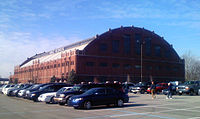
Athletics Athletics Hinkle Fieldhouse • Butler Bowl • Davey Athletic Complex • Bulldog Park • Health and Recreation ComplexPeople Buildings Butler University Buildings • Irwin Library • Clowes Memorial Hall • Holcomb Observatory and PlanetariumStudent life Infrastructure Butler University Police DepartmentHorizon League Members Butler Bulldogs • Cleveland State Vikings • Detroit Titans • Green Bay Phoenix • Loyola Chicago Ramblers • Milwaukee Panthers • UIC Flames • Valparaiso Crusaders • Wright State Raiders • Youngstown State Penguins

Championships & awards Pioneer Football League Current members Butler Bulldogs • Campbell Fighting Camels • Davidson Wildcats • Dayton Flyers • Drake Bulldogs • Jacksonville Dolphins • Marist Red Foxes • Morehead State Eagles • San Diego Toreros • Valparaiso Crusaders
Future members Mercer Bears (2013) • Stetson Hatters (2013)
Colleges and Universities in Metropolitan Indianapolis Anderson University • The Art Institutes-Indianapolis • Ball State University-Fishers Center • Ball State University-Indianapolis Center • Brown Mackie College-Indianapolis • Butler University • Christian Theological Seminary • Crossroads Bible College • DePauw University • Franklin College • Indiana Bible College • Harrison College • Indiana Institute of Technology-Indianapolis • Indiana University-Purdue University Indianapolis • Indiana Wesleyan University • ITT Technical Institute • Ivy Tech Community College of Indiana-Indianapolis • Kaplan College-Indianapolis • Lincoln Technical Institute • Marian University • Martin University • Medtech College • Oakland City University-Indianapolis • University of Indianapolis • University of Phoenix-Indianapolis • Wabash College • Wilson College
Associated New American Colleges Arcadia • Belmont • Butler • Drake • Drury • Elon • Evansville • Hamline • Hampton • Ithaca • North Central • Pacific Lutheran • Quinnipiac • Redlands • Scranton • Simmons • Susquehanna • The Sage Colleges • Valparaiso • Wagner • WestminsterCategories:- Council for Christian Colleges and Universities
- Butler University
- Educational institutions established in 1855
- Council of Independent Colleges
- National Association of Independent Colleges and Universities members
- North Central Association of Colleges and Schools
Wikimedia Foundation. 2010.

